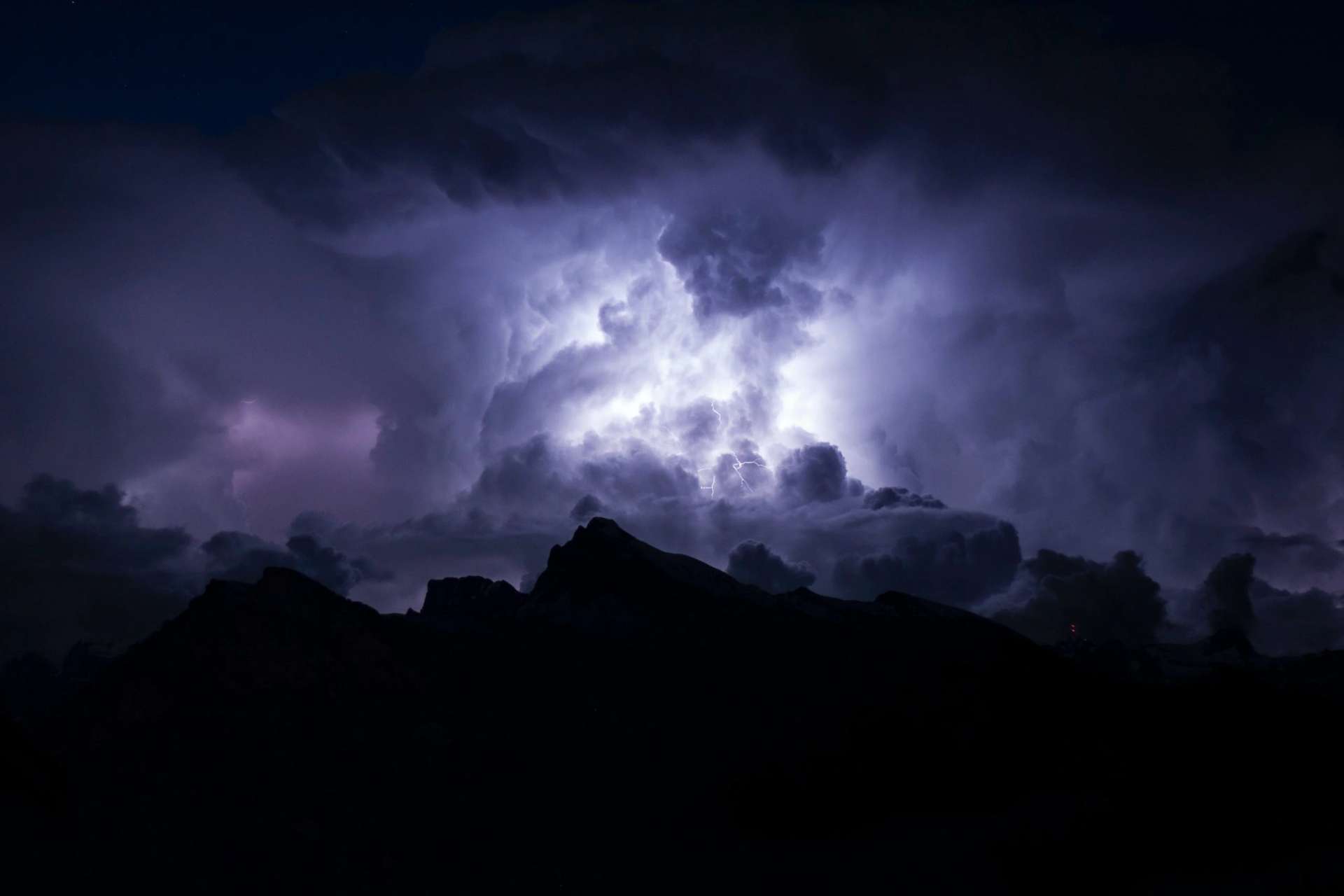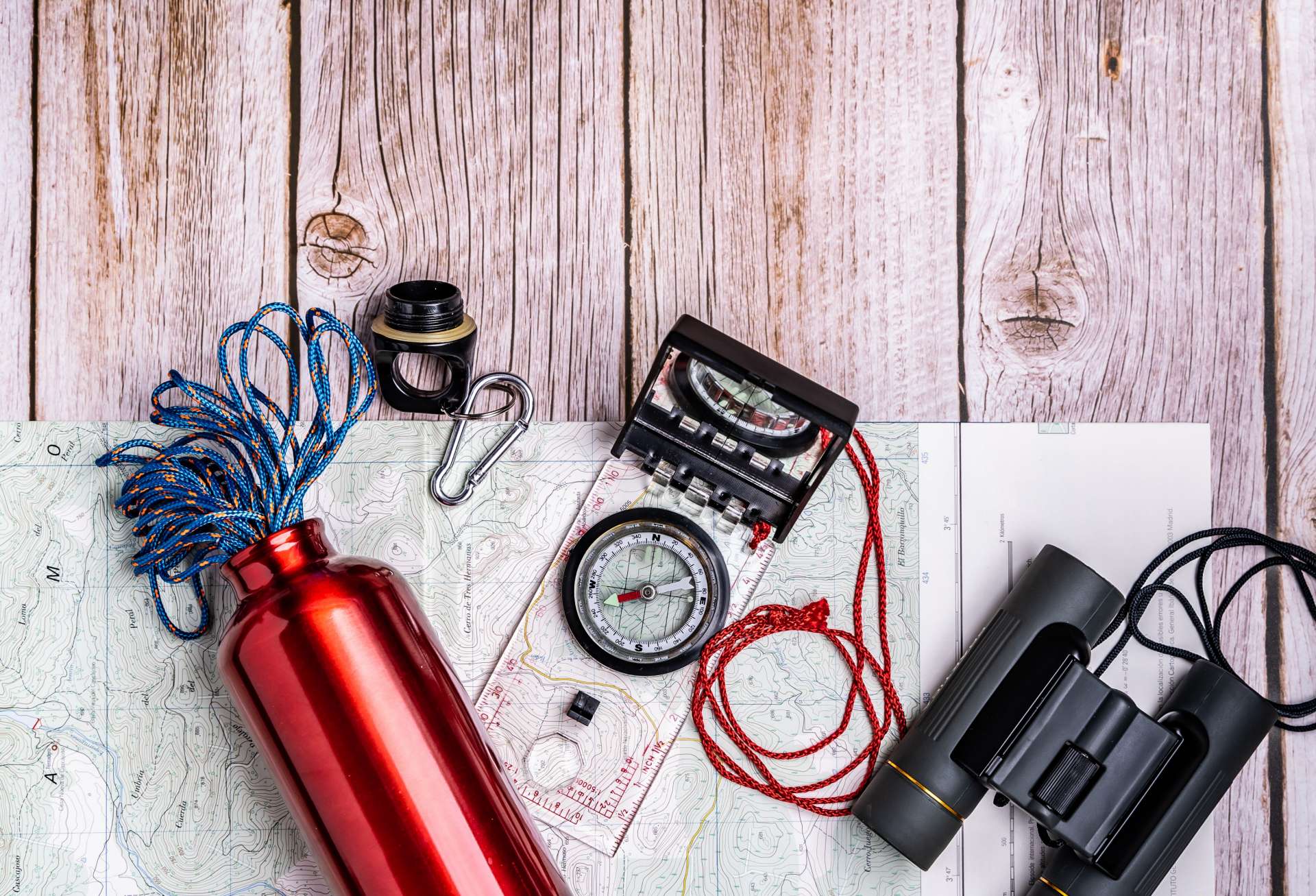Mountain hazards

Storms
Storms are commonplace in the mountains, especially on hot summer days. Some kinds of storms can develop very rapidly even when the skies are clear.
When this kind of phenomenon is approaching, move away from peaks, ridges and waterways, do not take shelter near runoff channels or chimneys and distance yourself from solitary trees and standing structures (pylons, poles, unusually tall solitary masses...). Move downhill and seek out dry cover.
If you are in a group when a storm takes you by surprise, leave about 10 meters between each individual (not hand in hand) as you search for shelter. Insulate yourself from the ground using your backpack, rope or any other poor conductor and get rid of any metal objects; do not light fires (which can attract electrical discharges) and wait out the storm: the average duration is about an hour.
To reduce the risk of being struck by lightning, the following should be added to the above precautions:
- if you have not already done so from home, check the conditions and weather forecast for your route at the guide offices;
- if you notice vertically developed clouds in the morning, then storms are likely to develop during the course of the day, and are even more likely if there is haziness and a sensation of stuffiness in the valleys;
- for storms that are already under way, the highest part of the cumulonimbus cloud (typical anvil-shaped cloud) will point out the direction in which the storm is headed;
- at nighttime, lighting flashes will be visible tens of kilometers away, but if you can hear the thunder then the storm is only a few kilometers away; a delay of about 10 seconds between the flash and the thunder means that your are about 3 kilometers away from the storm (no. of seconds x 340 m);
- remember - the average storm lasts about 1 hour, and the most intense phase rarely lasts longer than a half hour, so look for shelter (inside caves, not at the entrance) at the first signs of a storm and wait there until it begins to wane;
- stay away from rivers, which can rise rapidly and present a threat;
- direct lightning strikes are hazardous, but so are the so-called "ground strikes": the current from the lightning passes through the ground, decreasing in intensity as a function of distance from the strike point - as a consequence, it is important to be touching the ground surface at one point only, e.g., by standing on one foot or crouching with your feet together (there can be a dangerous difference of potential between the sole of one foot and the other; avoid lying down or leaning against the rock;
- even minor lightning strikes can generate enough current to trigger respiratory or cardiac arrest, burns and involuntary muscle contractions that can induce jerky, uncontrolled movements and even bone fractures. Powerful lightning strikes usually result in death.
After being struck by lightning, however, the victim is not electrically charged and it is safe to administer first aid. The survival rate for lightning strikes is about 80%: save a life with mouth-to-mouth respiration and cardiac massage (CPR)!
Temperature
Atmospheric temperature is highly variable in a mountain environment: changes in altitude, the arrival of cloud cover and passing from sunny to shady areas are some of the main causes of sudden temperature drops.
There are a variety of factors that cause the human body to get cold, wind is the an exemple.
Wind: an atmospheric agent that is often underestimated and that, as a consequence, can be the source of general discomfort or even outright pathologies. The human body is a machine that produces heat. The main purpose of clothing is not to produce heat, but to hold bodyheat in by insulating the body surface from the outside. The heat exchange between body and air is ongoing, as a matter of fact. In essence, we lose a modest part of our heat through conduction. When it is windy, however, the thin layer of heated air around our body is dispersed more rapidly, which speeds up the exchange of heat. This is why the sensation of coldness can increase significantly even when the air temperature remains unchanged (the "windchill" effect)
Snow and snowfields
Trails can be covered with a considerable amount of snow even early in the season. Beware of slipping hazards - if possible, bypass snowfields if they have even a minor slope and bring the proper equipment: crampons, ice-axe, telescoping poles, snow leggings.
Another snow-related risk concerns difficulties getting oriented: heavy snowcover can hide trail markings and make it difficult to find reference points and landmarks, especially during bad weather. Use a compass and a map or even a GPS.
Caution - following the tracks of other hikers can lead you even farther off the trail!
Keep in mind that waterways can be covered by snow bridges that may collapse under the weight of one or more excursionists, so be careful whenever hiking near rivers, streams and gulleys where water could meet up with snowfields. When a snow bridge has to be crossed, a safety line is recommended.
Slopes
Sloping of the ground can create a variety of different complications during the course of an excursion.
Grassy slopes, especially when humid, wet or covered with frost, are very slippery.
The risk of rockslides should never be underestimated, especially when other groups of excursionists are in the vicinity. Proceed with utmost caution when hiking above other groups, and always be aware of your position relative to the possible trajectories of falling rock when downhill from other groups.
While they may seem to offer convenient shelter from bad weather, large masses resting on an incline should never be trusted too much because of their precarious stability.
Never underestimate the potential problems inherent to peaks: open-air ridges, the traversal of very steep slopes and exposed segments can provoke fear and panic. Try to keep your group together and do not leave the trail, however overwhelming it might seem.
Do not try to take shortcuts, and if you ever lose the trail, the best strategy is to backtrack until you find a reliable point of reference.
Fog and limited visibility
Low clouds and fog are very common in mountainous environments. A compass, a map and an altimeter (and being sure you know how to use them) as well as a rescue whistle are handy in dangerous situations and can keep you from wasting significant amounts of time.
In the presence of fog, proceed as a group and follow the trail signs meticulously (even if you already know the way). When visibility is down to a minimum, stop and wait for better conditions instead of venturing out with risky explorations.
Solar radiation
We tend to underestimate just how harmful the sun's rays can be, especially ultraviolet radiation. They can alter the DNA of our skin cells and induce skin tumors (e.g., melanoma) and other dermatological diseases as well as problems related to the eyes, such as conjunctivitis, snow blindness, corneal burns, heavy tearing and photosensitivity.
The highest risk time time slot is during midday (from 11 am to 2 pm) around the summer solstice (June 21st). At this time at our latitudes, the sun's rays strike the earth at an angle of nearly 90°, which means the distance they travel through the atmosphere is at its shortest and has less of a filtering effect. In addition, the intensity of radiation increases by 7% for every 1000 meters in altitude, thanks to the increasing thinness of the air. In the mountains, therefore, conditions can vary considerably through the course of a single day.
Another factor to keep in mind is how snow and ice on the ground can increase the intensity of radiation by as much as 100%, thanks to their reflective capacity.
What to do:
- Wear UV filter sunglasses;
- Always use high protection sunblock;
- Avoid prolonged direct exposure of the skin to the sun (do not take naps in the sun or lay out to work on your tan);
- Take care of particularly exposed body zones (face, ears, neck, scalp, hands).
